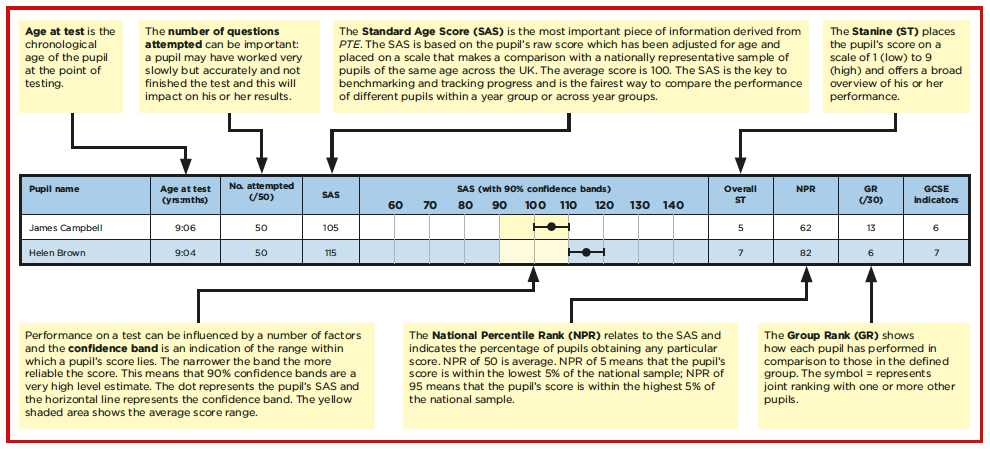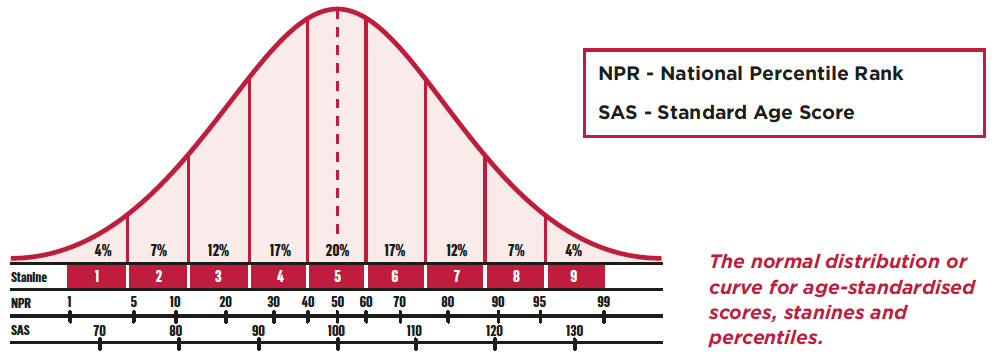How are standardised test results described?
Raw score: The raw score is the total number or points or marks the pupil has scored on the test. Standardised tests convert raw scores, for example 33 out of 50, to scores on a readily understandable scale, a normal distribution curve.
Standard Age Score: A Standard Age Score converts a pupil’s raw score to a standardised score which takes into account the pupil’s age in years and months and gives an indication of how the pupil is performing relative to a national sample of pupils of the same age. The average score is 100. A higher score is above average and a lower score is below average. The SAS is key to benchmarking and tracking progress and is the fairest way to compare performance of different pupils within a year group or across a year group.
"The Standard Age Score (SAS) is a recognised benchmark to measure against a national sample of pupils of the same age."
Stanine: The stanine places the pupil’s score on a scale of 1 (low) to 9 (high) and offers a broad overview of performance.
Confidence bands: The confidence band is an indication of the range within which a pupil’s score lies. The narrower the band the more reliable the score. Reliability values range from 0 to 1, with 0.9 being very high and 90% confidence bands showing strong reliability. This means that on 9 out of 10 occasions, the true value of the score is within the score band. Reliability can be determined by testing and re-testing a group of pupils and seeing how well the scores correlate between the two testing occasions.
Group Rank (GR): Group Rank shows how each pupil has performed in comparison to those in the group.
National Percentile Rank (NPR): The National Percentile rank relates to the SAS score and shows the percentage of pupils obtaining a certain score or below. A NPR of 50 is average since 50% of pupils obtained an SAS of 50 or below. A NPR of 5 indicates a pupil’s score is within the lowest 5% of the nationally representative sample and a NPR of 95 means that a pupil’s score is within the highest 5% of the national sample.

Reading age: Also known as age-equivalent score, reading age is the age at which a particular score is obtained by the average pupil. So for example, if the average raw score for a 7-year-old on a reading test is 50, any pupil with a raw score of 50 will have a reading age of 7 years. Reading age is a useful measure for when pupils join from another school to give an indication of their likelihood of having issues accessing the curriculum. Reading ages can also be used to measure the impact of reading interventions. In most cases, it is not sensible to relate scores for pupils with above average reading ages (above their chronological age) as age-equivalences by definition relate to an average.
Performance indicators: Indicators showing potential pupil attainment at the end of KS2 and GCSE. They are based on the significant and positive correlation (a link supported by statistical data) between a pupil’s scores on tests, and his or her performance in Key Stage 2 national tests and GCSE examinations. The performance indicators provide a reliable indicator of future performance. This analysis is based on results from a large sample of schools and pupils, and the indicators will be updated regularly to reflect changes in national KS2 attainment.

Was this useful?
Our priority is to ensure you have the information you need to get the best from our products, and would like to know if this page helped you find what you needed?

